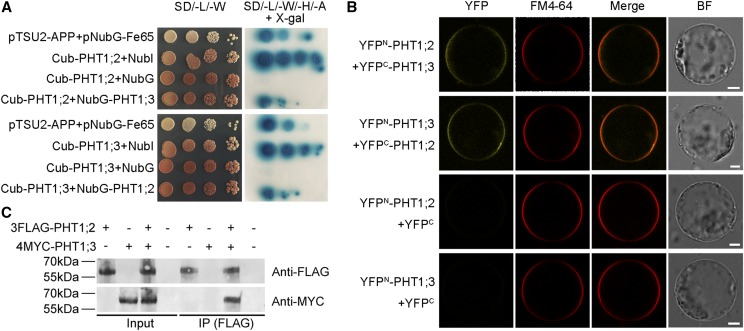Figure 9.
PHT1;3 physically interacts with PHT1;2. A, PHT1;3 interacts with PHT1;2, as indicated by split-ubiquitin Y2H assays. Coexpression of NubI or NubG with PHT1;2 or PHT1;3 was used as positive and negative controls, respectively. Also, the bait APP served as a control that could interact with Fe65. X-gal is a substrate of the bacterial enzyme β-galactosidase encoded by the color reporter gene lacZ. B, PHT1;3 interacts with PHT1;2 on the plasma membrane, as indicated by BiFC analysis. N- and C-terminal fragments of YFP (YFPN and YFPC) were fused to the N terminus of PHT1;3 and PHT1;2, respectively. The yellow signals indicate YFP, and the red signals indicate the plasma membrane that was specifically stained with the dye FM4-64. Scale bars = 10 μm. C, PHT1;3 interacts with PHT1;2, as indicated by Co-IP assays. Microsomal proteins were extracted from infiltrated N. benthamiana leaves transiently expressing FLAG-PHT1;2 and MYC-PHT1;3. Protein extracts (Input) were immunoprecipitated with anti-FLAG antibody (IP). Immunoblots were developed with anti-FLAG antibody to detect PHT1;2 and with anti-MYC to detect PHT1;3. SD/-L/-W, -Leu-Trp; SD/-L/-W/-H/-A, -Leu-Trp-His-Ade; NubI, N-terminal fragment of ubiquitin; NubG, the mutated N-terminal fragment of ubiquitin; BF, bright field.

